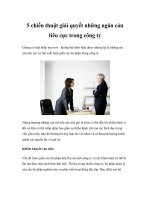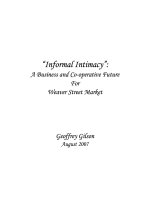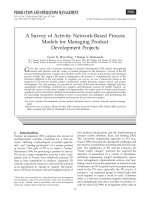A Simple 5 Step Split Testing Process That Almost Always Increases Conversions By Jason Fladlien docx
Bạn đang xem bản rút gọn của tài liệu. Xem và tải ngay bản đầy đủ của tài liệu tại đây (82.71 KB, 4 trang )
A Simple 5 Step Split Testing
Process That Almost Always
Increases Conversions
By Jason Fladlien
Published by JTD Creatives at Smashwords
Copyright © 2010 Jason Fladlien
License Notes
Thank you for downloading this free ebook. This free ebook may be copied,
distributed, reposted, reprinted and shared, provided it appears in its entirety
without alteration, and the reader is not charged to access it.
~~**~~
Intro
Split testing is where the money is at. And it's easy if you have a 5 step process to follow
- you literally just do it, step by step, and in most cases, with little effort - you'll be
making more money.
Sometimes a lot more money.
In this report we're going to show you a real easy 5 step split testing process that almost
anyone can follow that just crushes it.
You'll love it. Follow along, use it and profit it from it.
Step 1 Make Your FOUR Versions
Take whatever product you're currently offering right now - and create a second version
of the advertisement to split test against it.
Here's the only tweak you're going to make for this version - change the offer from a "one
time payment" to a "trial offer".
Example - If you're selling a product for $47 on weight loss change it.
Instead of $47 up front, they pay $2.95 to try out the product for 7 days. If they don't
cancel their trial within 7 days then at the end of 7 days they are billed $47 dollars.
The next page you're going to create is almost exactly the same - the only difference is
the trial period. It's now $2.95 for the first 14 days then $47 after the trial is up.
The last "version" you'll create is where we change the price. It's $2.95 for 7 days, then if
they don't cancel they'll be automatically billed $67.
That's it. You'll have four versions when you're done:
1. Your original advertisement
2. A $2.95 trial with balance due in 7 days
3. A $2.95 trial with balance due in 14 days
4. A $2.95 trial with a PRICE INCREASED balance due in 7 days
Step 2 - Set Up the Split Test
If you already have some great split testing software and know how to use it - then use it.
If not, here is a free solution for you that works just about as good as any.
It's called Google Optimizer -
It's easy to use. Pick A/B split-testing. Then put in your original advertisement page URL
and the URL someone would be forwarded to if they purchased your product or service
(called your conversion page).
Then put in your three experiment page URLs (the three split testing versions you created
in step 1). When you're done they'll give you further instructions on how to use a simple
code so that way Google can track it for you.
Now you're set!
Step 3 - Analyze Results
We specifically recommend Google Optimizer simply because it's SLIM. Meaning there
are not a ton of metrics - just conversion rates.
It's actually way too easy to get distracted by a ton of data and be more confused about
what to do than before you started split testing. That stuff has its place and will be used
later on after you get a solid winner.
For now, you're just going to wait until each page gets at least 100 unique visitors.
Ideally, you'd like at least 300 unique visitors, but if you don't get a lot of traffic then 100
is "good enough". It won't be as statistically valid but it will give you a good "ball park"
figure.
Once you get at least 100 unique visitors per page (or ideally 300) then you simply look
at your results. One of them will be better than the others. Simple as that.
Now that you have a "winner", let's use that version to see how much better we can make
it.
Step 4 - Headlines
Let's say the winner was the $2.95 trial for 7 days offer. So what you'd do is take this
page, and create 3 new pages to split test against the original version.
This time you're going to test it against a few alternative headlines. The first headline
should mention the fact that you are offering this for a $2.95 trial. The second headline
should be an "opposite length" headline.
Here's what we mean - if the headline on your winning split test page was long, try it
against a short headline.
For example, if you were selling golf product and your original winner had a short
headline that said, "Add 25+ Yards to Your Swing Before Your Next Round of Golf."
Then test it against a headline like this - "How An Awkward Military Ops Agent
Accidentally Discovered A Secret Army Technique For Adding 25+ Yards To Your
Swing Before You Play Your Next Round Of Golf The Secret Is In the Back Of Your
Heel "
Or vice versa. If the original winner had a "middle length" headline - neither very long or
very short - then create versions so you'll be testing a long headline, a short headline and
a medium headline that all have pretty much the same hook.
Also, ALWAYS test a simple, straight forward "how to" instant gratification headline.
This is a headline that starts with "how to" and promises a big benefit in a short, specific
period of TIME.
In this case it could be "How to Add 25+ Yards to Your Swing in 3 Minutes or Less".
So when you're done you have these headlines to test:
1. Your regular headline
2. Your regular headline with mention of the TRIAL OFFER (if a trial offers one)
3. A real short headline
4. A real long headline
5. An "average length" headline
6. A "how to" instant gratification headline
Roll it out and see which one wins. Then move on to the last step.
Step 5 - Long Vs. Short
Now we take your winner and put it through one more test. We want to test length. Take
your sales letter "as is" and split test it against a "shorter, more condensed" version and a
"longer, more thorough" version.
Let's say your sales letter is 4 pages long. Try to cut it down to 2 pages. Remove anything
you feel is not absolutely required. That's one version to test.
The other is to ADD to it. This usually means explaining additional benefits they get
from your product that you didn't mention before. It also means adding in more proof, if
you can, and also spending more time explaining why what you're offering is a good deal.
It also means adding more testimonials if you have them.
So now you have a short, medium and long sales letter to test. So test them and see what
happens.
If you follow this 5 step process, you can almost guarantee a dramatic improvement in
your results.
###
Connect with Me Online:
Blog:
Website: />Smashwords: />









